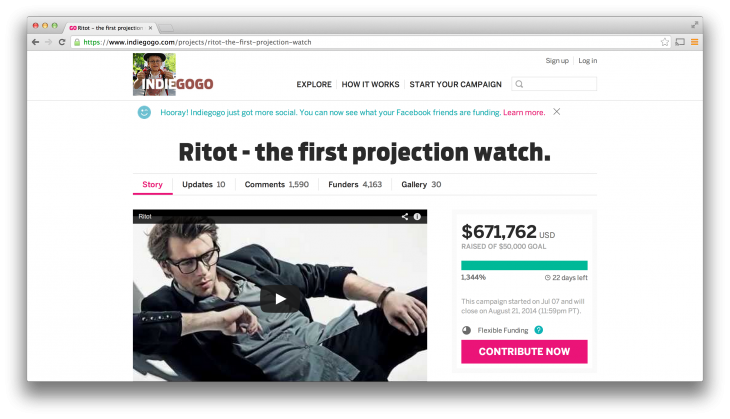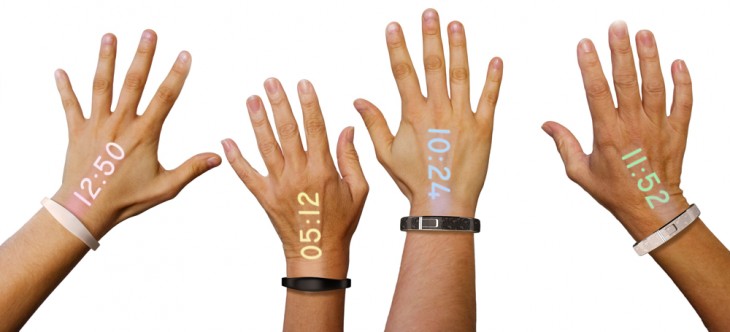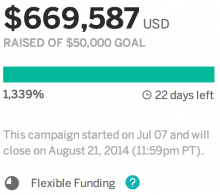
Writing about crowdfunding campaigns is a minefield. We don’t cover many, but when we do, we’re very careful to only bring you the highest quality projects. On one recent occasion, we may have missed the mark.
There are so many crowdfunding campaigns vying for attention that we reject well over 95 percent of the pitches we receive. After all, in most cases, they’re nothing more than pipedreams. At their best, crowdfunding campaigns bring fantastic products like the Pebble smartwatch and Oculus Rift into the world. At their worst, they can be scams designed to extract money from over-enthusiastic coolhunters.
The campaign we’re not sure about is the Ritot projection watch, listed on Indiegogo. Its aim is to fund the building of a watch that would project the time and various notifications onto your hand.
Now, personally, I wouldn’t want one of these but when we wrote about it on July 14, it had been live for a week and had already received backing of $114,200. So, there was clearly demand for it, and we wrote a short piece from the perspective of it being a successful crowdfunding project for an interesting idea. And then we moved on.
Red flags
Today we were contacted by Dmitry Goncharenko of Secret Layer, who sent us a PDF file detailing why he believed the project was a fake. He isn’t alone, this Connectedly post details similar points.
In summary, the red flags are:
- Doubts over whether the components required to make such a device work would fit into a casing the purported size of the Ritot.
- Doubts that a projector the size of the one inside the Ritot could create a bright enough image to make it usable in daylight.
- Doubts that the angle of the projection could create a clear image on the hand of the user.
- The fact that the publicity photos are (sometimes poorly) manipulated stock images and that there’s no working prototype to accompany the crowdfunding campaign.
These are bad enough, but then there’s the fact that we simply can’t find any sign of any of the Ritot founders online; not on Google, LinkedIn or Facebook. What’s more, it appears that they may well have changed their names during the campaign.
Goncharenko’s PDF and this Japanese blog post reference an earlier version of the campaign page that apparently showed different names for the team, and indeed more team members.
The person now listed on the campaign page as ‘Michael Medvid’, is in this version of the promotional video calling himself Ivan. Oh, and none of the founders have their identities listed as ‘verified’ on Indiegogo. Why not?
What’s more, the only version of the campaign page held on the Wayback Machine, from July 24, has an additional paragraph (now removed) in the section discussing the story of the company. It blames the name changes on the current political disruption in Ukraine, the country they claim to hail from despite earlier having stated they were from San Jose, California:
“Unfortunately, during all this time, we had political problems in our country, so we were not able to provide you with all detailed information about our team. In these hard days for our country we are working not only with our project, but also we are struggling for democracy and justice in our country.
“In this hard situation to avoid negative opinions we decided to specify only our aliases and address of our office in San Jose. It was a big mistake for which we are sorry. But since your trust is more important for us and you could be sure in our project, we would like to be absolutely honest with you. So we decided to provide you with the following honest information about our team. We had provided our passports and other proof information to Indiegogo to make sure that you can trust our company. Thank you for understanding.”
For its part, Indiegogo says: “The Ritot team has been responsive and cooperative with our inquiries and their campaign continues to be in compliance with our Terms of Use.”
Still, why would this section of the campaign page have been deleted if the backers wanted to remain transparent?
A final, smaller but not insignificant, red flag is that Ritot is raising money using an Indiegogo Flexible Funding campaign. These campaigns give the project organizers all the money raised during a campaign, even if it doesn’t reach its goal. If you were going to scam people out of their money, you wouldn’t even have to fool a lot of people – just enough people to raise some money, and then run. What’s more, if you’re legitimately working on an early-stage hardware project and don’t raise your full target, how are you supposed to complete the project? You’ll have some money in your pocket, but not enough for even your own estimate of the total cost.
This isn’t the first time Indiegogo campaigns have come under scrutiny. Take the example of the Healbe calorie-counting wristband that was investigated by Pando. That raised more than $1 million dollars earlier this year despite claims from experts that the device was impossible to make. The Ritot has raised $669,587 at the time of writing and it still has 22 days of its campaign remaining.
Plenty of people have raised concerns about the Ritot – just check the comments page of the campaign. Finding people to defend it (beyond Ritot’s own comments) is more difficult. Smart Crowdfunding, the company Ritot employed to do its PR (and that advertises flat fee prices of between $99 and $699 for its services) tells us: “As we provide Marketing and Promotion services to crowdfunding campaign creators who operate campaigns on various platforms, it is beyond our scope of work to authenticate or validate their offerings.”
For its part, Ritot (in the campaign’s comments section) claims to be making a list of people who have requested refunds. Even if that’s true and it honors all refund request, our concerns about the project remain valid.
Expert opinion
We spoke to Raymond Soneira, President of DisplayMate, who has consulted for projector manufacturers on projection technology, including pico and pocket projectors. He said that that the mockup images used by Ritot are “totally fake and wrong.”
“Because the hand is not perfectly flat, the projected numbers on the hand would never look perfectly uniform as if they were projected onto a perfectly flat screen. The hand is curved and uneven with many irregularities and bumps. The projected numbers would continually deform depending on how your hand flexed, and also how the wrist was bent,” Soneira says.
“Even if the hand were perfectly flat, the projected numbers would not look like that because they are being projected at a glancing angle so the numbers would nonlinearly stretch out because the bottom of the number is much closer to the watch than the top of the number,” he adds. “And that would also depend on the angle (at which) the wrist was bent.”
Finally, Soneira questions the quality of the projector within the Ritot. “Projecting nice looking numbers and graphics requires a high quality lens, but the tiny lens on the watch is unlikely to be very good. A projector requires a lot more light than a watch with a direct view LCD or OLED or microLED display – so where is the bright light source and the hefty battery for it?”
What now?
The Ritot may be an incredibly (over-)ambitious project from a group of people with poor marketing skills or it may be an intentional fake. We’ve had no response yet from the Ritot press queries email address, seven hours after we contacted it. On the campaign page’s comments section, Ritot has promised a video of a working prototype within 23 days. We’d love our concerns to be proven wrong, guys.
We’ll update you when we know more but we wanted to share what we know now and highlight an issue that everyone needs to keep in their minds if they have anything at all to do with crowdfunding.
We were far from the only publication (and certainly not the first) to write about the Ritot. USA Today, Slashgear, Mashable, Cnet and many more ran pieces too. The red flags were missed, ignored or brushed over by all of them. We all let an interesting-looking product take priority over critical thinking.
In The Next Web’s case, we have guidelines about what crowdfunding campaigns can be covered – they need to have a known, credible person attached to them or have a working prototype. In this case we didn’t follow our own guidelines. The piece went through our usual editorial process and it shouldn’t have got as far as being published. For that, we apologize.
Press reports can lend an air of credibility to a crowdfunding campaign. Media outlets should take that responsibility seriously.
UPDATE: A reader has emailed us to point out that Ritot used to list the address of a $65 per month San Jose virtual office space as its base (you can see it listed in the Wayback Machine copy of the campaign page). Our reader says it was removed after he pointed out the office’s identity in the campaign’s comments. The ‘unstable Ukraine situation’ story would explain this away (as they say they foolishly pretended to be based in San Jose) but we’re still waiting to hear directly from Ritot.
UPDATE 2: Ritot has responded – unconvincingly – to our concerns in a Q&A.
Josh Ong contributed research to this article.
Indiegogo header image credit: Shutterstock
Get the TNW newsletter
Get the most important tech news in your inbox each week.









